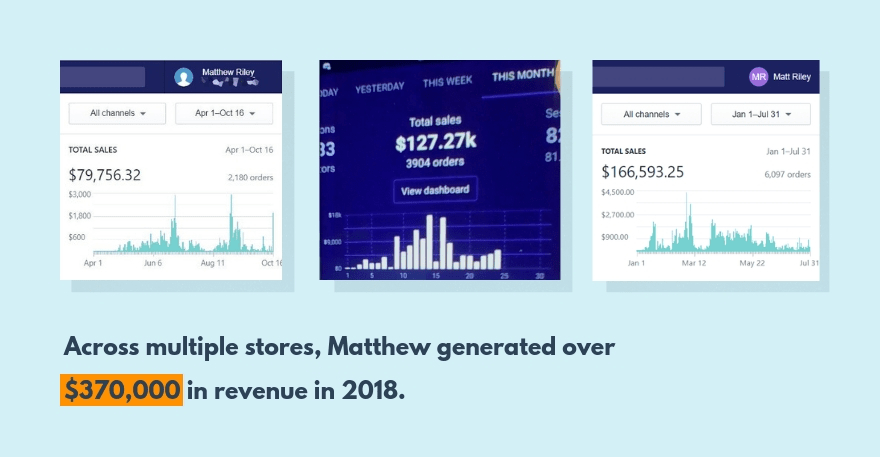Just over a year ago, Matt Riley’s life looked much like any other 24-year-old’s.
He’d recently graduated college, and not knowing what to do next, found himself falling into an uninspiring office job.
The protein powder company where he was working in Southern California was by all accounts a good job. His work as a customer service agent was interesting enough, the people were friendly, and the company was doing well. But Matt felt out of place.
And as he stared down the prospect of a long career toiling beneath fluorescent office lights, he began to feel trapped.
“It was a good job, but I felt so tied down that I didn’t really want to be there anymore. I just wanted to work for myself,” he says.
He’d left college with a degree in business entrepreneurship, and always wanted to start his own thing, but assumed he would begin maybe 10 years down the road.
But now it was less year out from graduation, and he was already becoming restless. His mind started to wander, searching for different ways that he could start something on his own.
It was on YouTube that Matt first discovered Shopify and dropshipping, and learned about businesses that were built using the dropshipping business model. The model, which allows entrepreneurs to start an ecommerce business without the need to purchase any inventory, was instantly appealing. “It seemed like a really easy way to get started,” he says.
Inspired by the possibilities, things started to move quickly. Within a week of first learning about the dropshipping business model, he had launched his first store.



His First Steps Into Ecommerce
The store sold clothes and toys for babies, and Matt felt confident that he could attract plenty of customers.
After all, new moms were part of the generation that had grown up with the internet, so he knew they would be comfortable shopping online. Plus, because they were a little older, they likely had money to spend. So the sales should come easy right?
→ Click Here to Launch Your Online Business with Shopify
“To be honest it was hard at first. I wasn’t profitable for the first four months, and I was struggling. Every day I would come home from my full-time job where I was working 40 hours a week and just work all night and try to make it profitable.”
As a first time entrepreneur, he felt overwhelmed by everything he didn’t know. And as a solo entrepreneur, he suddenly found himself wearing several new hats. He was juggling the responsibilities of a product manager, designer, customer service agent, and digital marketer all at once.
He continued to open new stores in different product niches, trying to find the right fit.
“The first one that was really, really profitable was a fashion store,” he says. “It kind of just took off. I had products that were selling, and I had Facebook ads that were working well. It was amazing.”
Since then he has expanded his businesses, setting up stores that sell kitchen products, pet products, religious products, video game accessories, and three general stores that sell a variety of products.
Some of them flopped and were ultimately shut down. But he kept pushing forward, following new ideas and creating new stores. Trial and error. Test and repeat.
Slowly, things started to fall into place. Matt watched as more of the stores pulled ahead, eventually generating up to six-figures of revenue in a single month.
Taking The Leap into Full-Time Business
Around a year after he first began dropshipping, he found himself at a crossroads. He noticed that he had started to make more money with the stores than he was making in his customer service job.
He knew the moment had come, and he had to quit.
“One of my bosses said he kind of saw it coming. He was kind of surprised that I was there and not doing bigger and better things,” he says.
Now he spends his days working on his different businesses full-time. He’s scaled them to the point that they generated more than $370,000 in 2018.

It’s a pretty good life, he admits.
“Here I am today, and I’m still dropshipping. I love it. I get to work from home, and I get to work whenever I want. I can go on vacation and travel whenever I want.”
However the journey to this point hasn’t been all peaches and cream. There’s been slip-ups and setbacks, and many late nights spent staring bleary-eyed at a computer screen full of sales data.
Now just over a year on, he’s looking back at the journey and sharing three essential lessons he learned during his transformation from a complete beginner to a full-time ecommerce entrepreneur.
This Thing Is Harder Than It Looks, But That’s What Makes It So Exciting.
As delicious as the idea of instant success might sound on first thought, the truth tastes much more like steamed broccoli than apple pie.
Truth: Overnight success is a myth.
Really good things take a lot of work, but the journey of undertaking that work and eventually coming out on top is the exciting bit.
Like Mark Manson says in his best-selling book The Subtle Art of Not Giving a F*ck: “This is the most simple and basic component of life: our struggles determine our successes.”
Matt knows this all too well. In the beginning, when he was facing the wall of things he did not know, and his stores were losing money, the struggles felt almost insurmountable.
“The biggest challenge was getting through that initial learning curve,” he says. “But you’ve just gotta keep going until you really hit that winner, and hit that profitability.”
“It’s so easy to give up. Even after the first month, I felt like, ‘This just doesn’t work. I’ve gotta quit.’ But I just kept pushing, and I just kept going.”
In the beginning, between his full-time job and his online stores, he was pouring over sixty hours a week into work. “It was very stressful, and I didn’t have any free time. But I knew it was worth it,” he says. “I felt like I wasn’t going to get anywhere with a full-time job, and that there was no way I was going to be able to work for myself that way. It felt like this was the only option.”
When things do start to pick up with your business, it can be tempting to jump the shark and quit your job so you can throw yourself at the business full-time.
It’s worth holding on a little longer, Matt suggests. “Anyone out there who is trying to get into dropshipping, don’t quit your jobs immediately,” he says.
“You want to have a fallback. You want to have that steady flow of income to pump money into your ads until you’re profitable. And when you feel like you’re ready and you’ve replaced your income on a consistent basis, go ahead and make the decision to quit or not.”

See That Box? You Need to Think Outside of It.
The world of entrepreneurship and ecommerce is full of plenty well-meaning people trying to tell you what will work for your business (hey, that sounds like me!). But the truth is, there isn’t a one-size-fits-all formula for success, and the best entrepreneurs realize this. They’ll remain open-minded and flexible, and adapt their strategy based on different products or target markets.
Instead of restricting himself to one narrow product niche, Matt runs multiple stores simultaneously so that he can find a place for a wide variety of products. Narrowly-focused niche stores and general stores that stock a wide range of products both have unique advantages and disadvantages, and Matt plays each to their strengths.
“The benefits of a general store is that you’re not limited to a certain group of products,” Matt explains. “With my fashion store, I can only advertise fashion items. But with the general store, let’s say something pops up and I don’t know what category it fits in, I can just put it on my general store.”
For your customers, the experience of shopping in each type of store is different too.
“The benefits of having a niche store is that your conversation rate will increase.”
“Let’s say we’re talking about a beanie; the messy bun beanie sold well last winter. But it has a higher conversion rate on my fashion store versus the general store. Because when customers are going to the niche store, they feel like they are at home, or have a deeper connection with the brand.”
When it comes to picking products to sell, Matt thinks about marketing first, not second. He chooses products based on if he thinks they will sell well on Facebook ads or Google shopping ads, the two marketing channels he mastered.
“If I’m looking for a full force in Google shopping ads, then I’m looking for products based on the search volume,” he says. “For Facebook, it has to be a little bit different. It has to be unique, and it has to have viral potential through video marketing.”
By thinking about how he’s going to sell the products before what he is going to sell, he’s setting himself up for success from the beginning.
“If you stick to one product, or you stick to one niche or targeting or audience, then you’ll fail.”
So stay open-minded and flexible.
And remember, when you’re flexible you’re less likely to break.

Unfortunately, You’re Not a Psychic. But Data Helps.
You might have been able to pick the winner of every season of Survivor, and sure, that crystal ball you bought on eBay looks nice in your living room, but sorry to inform you – you’re not a psychic.
There is no way to predict the future, and what happens with your business will often surprise you.
“I’ve had products that I thought were going to do really well and they were a flop,” Matt says. “Then I’ve had others that I had no idea were going to do so well. I just put them on the store and advertised them to get it over with and get it done with.”
And because the future is so wildly unpredictable, it pays to test everything.
“Focus on A/B testing, for sure,” Matt says. “Test a lot. Test a lot of different products. Test a lot of different ads. A lot of different ad types. A lot of different targeting. You’ll eventually find one that is profitable.”
Then after every test, follow what the data tells you. You’ll need to look for what’s working that you can replicate, and what’s worth giving up. Your intuition has a nasty habit of tripping you up, but the data never lies.
With an ecommerce business built using dropshipped products, you won’t need to purchase bulk stock of the inventory before you can test it. That means you’ll be able to test many different products quickly and cheaply without the fear of ending up with a warehouse of product nobody wants to buy. Something doesn’t sell? That’s fine, move onto the next one.
In the end, it often comes down to a numbers game.
“Imagine trying to throw a dart at the center of a target,” says Matt.
“Some people might get it first try, but most of the people won’t. You kind of have to throw 10, 20, 30 darts at the target until you hit the center. Some things are just not going to work. A lot of stuff is just going to flop. But once you hit the center, once you are profitable, you can scale that up. You’ll get that one, really good high-selling product, and that will cover for all of your losses.”



